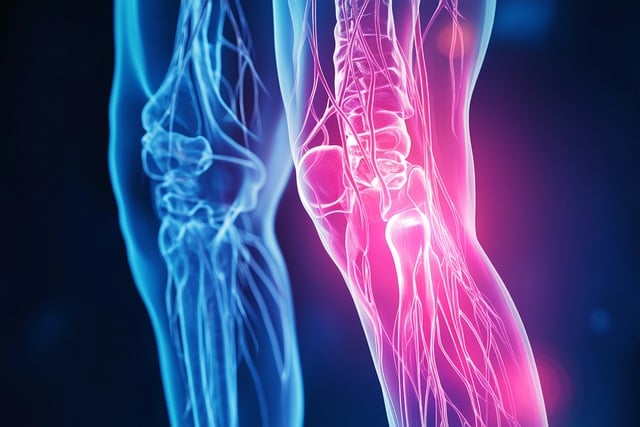Regenerative pain management represents a paradigm shift in the treatment of chronic pain, harnessing the body's innate healing mechanisms to provide non-invasive and sustainable relief. This approach focuses on repairing and regenerating damaged tissues through advanced therapies such as stem cell therapy, platelet-rich plasma (PRP) injections, and prolotherapy, which are part of recovery through regenerative medicine. These methods offer natural pain relief by leveraging growth factors and cytokines, addressing the root causes of chronic pain rather than merely managing symptoms. The field is continuously evolving with research aimed at enhancing the effectiveness of these treatments. By offering a personalized, minimally invasive path to recovery, regenerative pain management presents an exciting alternative to traditional surgical and medication-centric strategies, promising improved health outcomes and a better quality of life for those suffering from chronic pain conditions. Keywords: regenerative pain management, pain relief therapies, non-invasive pain treatments, advanced pain management, tissue regeneration.
Embark on a transformative journey into the realm of regenerative pain management, where innovative approaches promise to reshape the future of healing. This article delves into the groundbreaking pain relief therapies that offer natural pain relief through recovery via regenerative medicine. We explore the non-invasive pain treatments that mark a significant leap in chronic pain management and shed light on the science behind tissue regeneration, elucidating the intricate mechanisms at play within these advanced solutions. Join us as we provide a comprehensive guide to harnessing the potent benefits of non-surgical regenerative therapies for sustained recovery.
- Unveiling the Potential of Regenerative Pain Management: A Closer Look at Advanced Pain Relief Techniques
- Exploring Natural Pain Relief: The Role of Recovery Through Regenerative Medicine in Chronic Pain Management
- Non-Invasive Pain Treatments: How Cutting-Edge Regenerative Solutions Revolutionize Healing
- The Science Behind Tissue Regeneration: Understanding the Mechanisms in Regenerative Recovery Solutions
- A Comprehensive Guide to Non-Surgical Chronic Pain Management: Harnessing the Power of Regenerative Therapies for Sustained Recovery
Unveiling the Potential of Regenerative Pain Management: A Closer Look at Advanced Pain Relief Techniques

Regenerative pain management represents a transformative frontier in the realm of chronic pain management, leveraging the body’s innate capacity for healing through advanced pain relief therapies. These innovative techniques are rooted in recovery through regenerative medicine, offering patients non-invasive options that harness natural pain relief mechanisms without the need for surgery or long-term medication reliance. Stem cell therapy and platelet-rich plasma (PRP) injections are prime examples of such treatments, where cells and growth factors are precisely applied to repair damaged tissues, alleviating pain and restoring function.
The potential for tissue regeneration within this field is vast, with ongoing research continually refining these recovery solutions to enhance their efficacy. Unlike traditional pain management methods that often address symptoms rather than underlying causes, regenerative pain relief therapies target the root of the issue, providing sustained relief and promoting long-lasting healing. This paradigm shift in pain management not only improves patient outcomes but also offers a more holistic approach to health and wellness, ensuring that individuals can return to their daily activities with less pain and greater vitality.
Exploring Natural Pain Relief: The Role of Recovery Through Regenerative Medicine in Chronic Pain Management

Regenerative pain management represents a paradigm shift in how we approach chronic pain. Unlike traditional methods that often rely on long-term medication, regenerative medicine harnesses the body’s innate healing processes to repair and replace damaged tissues. This natural pain relief approach not only alleviates symptoms but also addresses the underlying issues by promoting tissue regeneration, leading to a more sustainable recovery through regenerative medicine. Advanced pain management techniques such as platelet-rich plasma (PRP) injections and stem cell therapy have emerged as effective, non-invasive pain treatments, offering patients hope for a life less encumbered by pain. These innovative therapies are designed to integrate seamlessly with the body’s repair mechanisms, fostering healing and reducing reliance on potentially harmful pharmaceuticals. As such, recovery through regenerative medicine stands as a beacon of hope for those suffering from chronic pain conditions.
Non-Invasive Pain Treatments: How Cutting-Edge Regenerative Solutions Revolutionize Healing

Regenerative pain management has taken a significant leap forward with the advent of pain relief therapies that offer recovery through regenerative medicine. These innovative treatments provide non-invasive pain treatments that are changing the landscape of chronic pain management. Unlike traditional methods, these therapies harness the body’s own healing mechanisms to repair and regenerate damaged tissues, leading to natural pain relief without the need for surgery. Advanced pain management techniques such as platelet-rich plasma (PRP) injections, stem cell therapy, and prolotherapy have emerged as potent solutions for those seeking alternatives to invasive procedures. These treatments are not only less traumatic but also offer a more holistic approach to healing by promoting tissue regeneration and restoring function to affected areas.
The integration of regenerative recovery solutions into pain management protocols has been a game-changer for individuals suffering from acute or chronic pain conditions. Unlike the one-size-fits-all approach of conventional medicine, these therapies are personalized to address the underlying causes of pain. This personalization not only enhances the effectiveness of treatment but also minimizes the potential for side effects, offering a safer and more efficacious path to recovery. The use of natural pain relief methods is particularly beneficial for patients who wish to avoid the risks associated with long-term medication use or those who have exhausted other treatment options without success. As such, these cutting-edge regenerative solutions are becoming increasingly popular, providing patients with a newfound hope and a viable alternative to traditional pain management strategies.
The Science Behind Tissue Regeneration: Understanding the Mechanisms in Regenerative Recovery Solutions

Regenerative pain management represents a paradigm shift in chronic pain management, offering recovery through regenerative medicine that harnesses the body’s innate capacity for self-healing. At the heart of these advanced pain management solutions lies tissue regeneration, a process facilitated by the strategic application of natural pain relief alternatives such as stem cell therapy and platelet-rich plasma (PRP) injections. These non-invasive treatments are designed to stimulate the proliferation of healthy cells, promoting the restoration of damaged tissues and alleviating pain without the need for surgeries or long-term pharmaceutical interventions.
The mechanisms behind tissue regeneration are rooted in biological signaling pathways that are activated by the body’s own growth factors and cytokines. When injured, the body initiates a complex cascade of events that involve inflammation, cell differentiation, and ultimately, tissue repair or replacement. Regenerative recovery solutions aim to enhance this process by supplementing the natural response with concentrated doses of healing agents. These agents work to accelerate the regeneration process, reduce inflammation, and stimulate the production of new, functional tissues, thereby offering a viable route for pain relief therapies that can restore function and quality of life to individuals suffering from various forms of chronic pain.
A Comprehensive Guide to Non-Surgical Chronic Pain Management: Harnessing the Power of Regenerative Therapies for Sustained Recovery

Regenerative pain management represents a paradigm shift in addressing chronic pain. Advancements in regenerative therapies offer natural pain relief by harnessing the body’s innate healing mechanisms. These innovative treatments, such as platelet-rich plasma (PRP) injections and stem cell therapy, provide targeted pain relief without the need for invasive surgeries. By stimulating tissue regeneration, these therapies not only alleviate symptoms but also foster recovery through regenerative medicine, promoting sustained recovery and improved function for patients suffering from various conditions.
Chronic pain management has been revolutionized with the advent of non-invasive pain treatments that are less taxing on the body compared to traditional methods. The use of regenerative pain relief therapies like hyaluronic acid injections and prolotherapy can restore damaged tissues, leading to long-lasting relief. These approaches are tailored to the individual’s unique needs, ensuring a personalized recovery trajectory. As such, regenerative recovery solutions offer a promising alternative for those seeking to manage chronic pain effectively, with minimal downtime and the potential for a restored quality of life.
Regenerative pain management stands at the forefront of medical innovation, offering a beacon of hope for those grappling with persistent discomfort. This article has delved into the multifaceted benefits of pain relief therapies that harness the regenerative potential of the body, emphasizing recovery through regenerative medicine as a non-invasive approach to chronic pain management. The mechanisms underlying tissue regeneration hold great promise for those seeking sustained recovery without the need for surgery. As we continue to explore and understand these advanced pain management solutions, it becomes increasingly clear that regenerative recovery solutions represent a pivotal shift in how we approach healing. By integrating these cutting-edge treatments into clinical practice, we can offer patients not only relief from their immediate pain but also the possibility of long-term improvement in their overall well-being. The future of pain care is undoubtedly regenerative.
